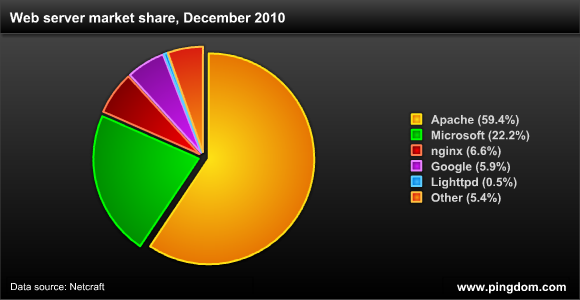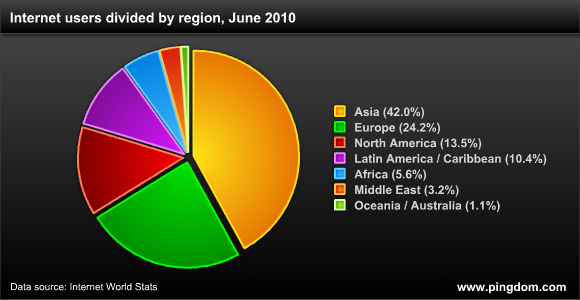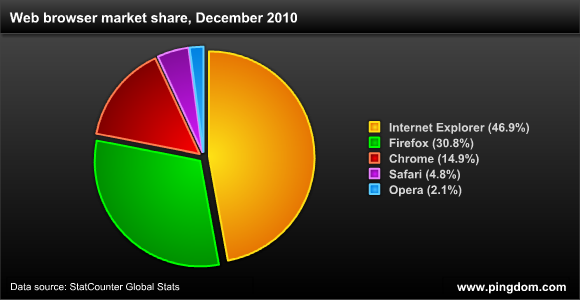
What happened with the Internet in 2010?
How many websites were added? How many emails were sent? How many Internet users were there? This post will answer all of those questions and many, many more. If it’s stats you want, you’ve come to the right place.
We used a wide variety of sources from around the Web to put this post together. You can find the full list of source references at the bottom of the post if you’re interested. We here at Pingdom also did some additional calculations to get you even more numbers to chew on.
Prepare for a good kind of information overload. 😉
- 107 trillion – The number of emails sent on the Internet in 2010.
- 294 billion – Average number of email messages per day.
- 1.88 billion – The number of email users worldwide.
- 480 million – New email users since the year before.
- 89.1% – The share of emails that were spam.
- 262 billion – The number of spam emails per day (assuming 89% are spam).
- 2.9 billion – The number of email accounts worldwide.
- 25% – Share of email accounts that are corporate.
Websites
- 255 million – The number of websites as of December 2010.
- 21.4 million – Added websites in 2010.
Web servers
- 39.1% – Growth in the number of Apache websites in 2010.
- 15.3% – Growth in the number of IIS websites in 2010.
- 4.1% – Growth in the number of nginx websites in 2010.
- 5.8% – Growth in the number of Google GWS websites in 2010.
- 55.7% – Growth in the number of Lighttpd websites in 2010.

Domain names
- 88.8 million – .COM domain names at the end of 2010.
- 13.2 million – .NET domain names at the end of 2010.
- 8.6 million – .ORG domain names at the end of 2010.
- 79.2 million – The number of country code top-level domains (e.g. .CN, .UK, .DE, etc.).
- 202 million – The number of domain names across all top-level domains (October 2010).
- 7% – The increase in domain names since the year before.
Internet users
- 1.97 billion – Internet users worldwide (June 2010).
- 14% – Increase in Internet users since the previous year.
- 825.1 million – Internet users in Asia.
- 475.1 million – Internet users in Europe.
- 266.2 million – Internet users in North America.
- 204.7 million – Internet users in Latin America / Caribbean.
- 110.9 million – Internet users in Africa.
- 63.2 million – Internet users in the Middle East.
- 21.3 million – Internet users in Oceania / Australia.

Social media
- 152 million – The number of blogs on the Internet (as tracked by BlogPulse).
- 25 billion – Number of sent tweets on Twitter in 2010
- 100 million – New accounts added on Twitter in 2010
- 175 million – People on Twitter as of September 2010
- 7.7 million – People following @ladygaga (Lady Gaga, Twitter’s most followed user).
- 600 million – People on Facebook at the end of 2010.
- 250 million – New people on Facebook in 2010.
- 30 billion – Pieces of content (links, notes, photos, etc.) shared on Facebook per month.
- 70% – Share of Facebook’s user base located outside the United States.
- 20 million – The number of Facebook apps installed each day.
Web browsers

Videos
- 2 billion – The number of videos watched per day on YouTube.
- 35 – Hours of video uploaded to YouTube every minute.
- 186 – The number of online videos the average Internet user watches in a month (USA).
- 84% – Share of Internet users that view videos online (USA).
- 14% – Share of Internet users that have uploaded videos online (USA).
- 2+ billion – The number of videos watched per month on Facebook.
- 20 million – Videos uploaded to Facebook per month.
Images
- 5 billion – Photos hosted by Flickr (September 2010).
- 3000+ – Photos uploaded per minute to Flickr.
- 130 million – At the above rate, the number of photos uploaded per month to Flickr.
- 3+ billion – Photos uploaded per month to Facebook.
- 36 billion – At the current rate, the number of photos uploaded to Facebook per year.
Data sources and notes: Spam percentage from MessageLabs (PDF). Email user numbers and counts from Radicati Group (the number of sent emails was their prediction for 2010, so it’s very much an estimate). Website numbers from Netcraft. Domain name stats from Verisign and Webhosting.info. Internet user numbers and distribution from Internet World Stats. Facebook stats from Facebook and Business Insider. Twitter stats from Twitter (and here), TwitterCounter and TechCrunch. Web browser stats from StatCounter. YouTube video numbers from Google. Facebook video numbers from GigaOM. US online video stats from Comscore and the Pew Research Center. Flickr image numbers from Flickr. Facebook image numbers from this blog.



























